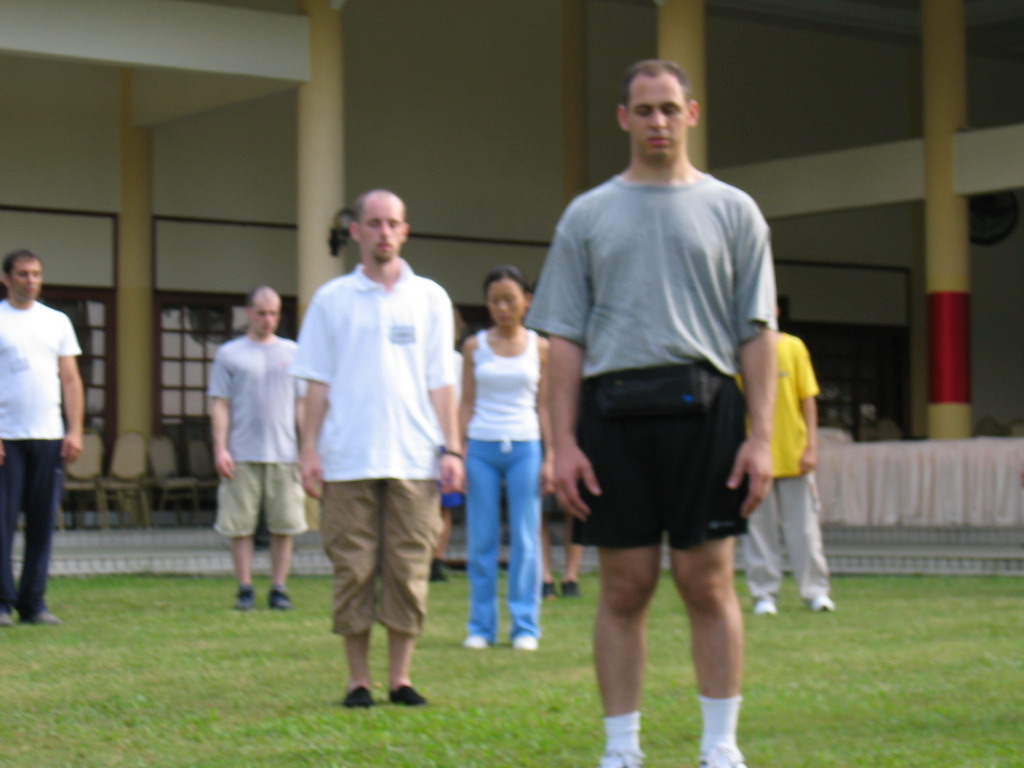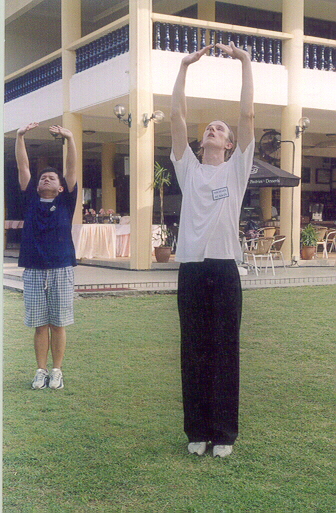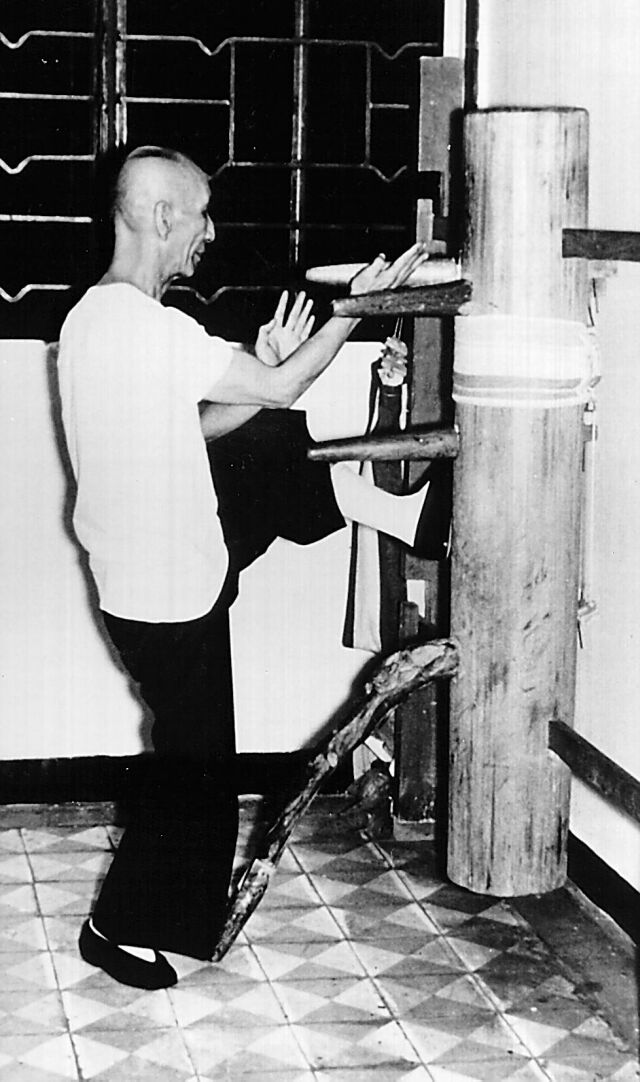June 2005 (Part 3)
SELECTION OF QUESTIONS AND ANSWERS

Spiritual cultivation is an integral part of kungfu training in Shaolin Wahnam. Here participants of the Intensive Shaolin Kungfu Course in Malaysia in November 2004 entered into a deep level of Zen at the end of a training session.
Question 1
I would also like to know if it is true that I am unable to practice Chi Kung and Kung Fu simultaneously for the next five years to come.
— Niklas, USA
Answer
This depends on whom you learn from. In our school, it is not true. If you learn Shaolin Kungfu or Wahnam Taijiquan from us for five years or even three hours, you will have practiced kungfu and chi kung simultaneously for five years or three hours.
Editorial Note: You can find Niklas' earlier questions in the previous issue, June 2005 Part 2, of the question-answer series.
Question 2
I wonder if it is possible for me to practice exercises like “Lifting the Sky” and “Carrying the Moon”, which are perhaps more basic exercises than “Lohan Embracing Buddha”, or at least not as powerful.
Answer
If all other factors were equal, “Lifting the Sky” and “Carrying the Moon” are more powerful than “Lohan Embracing Buddha”.
Basic exercises can be, and often are, very powerful.
Question 3
I do not doubt my master because he seems to really know what he is talking about, but I did find it a bit surprising since it is not mentioned in “The Art of Shaolin Kung Fu” or “The Art of Chi Kung” that Chi Kung is not recommended for people aged about 22-25. Perhaps he was referring to complete or more advance Chi Kung and not only basic exercises?
Answer
There is no surprise. It is not mentioned because it is not true. Chi kung and kungfu are recommended for people of all ages.
Question 4
I do not wish to practice Chi Kung to develop spiritually yet (although I would very much like to do so in the future), but have decided to start by practicing only to get better health, and I consider buying your book “Chi Kung for Health and Vitality” in order to achieve this. Can I practice any exercise I feel like in the mentioned book or are there some exercises I should avoid?
Answer
As long as you practice genuine chi kung, even if it is of a low level, you will develop spiritually, because genuine chi kung cultivates the physical body, the energy and the spirit. In low level chi kung, the benefit of spiritual development may be too little to be easily noticeable, whereas in high level chi kung the spiritual experience can be very powerful.
As some people may have the misconception that genuine chi kung or genuine kungfu must necessarily be of a high level, the following explanation will be helpful.
I use the term “genuine chi kung” to highlight its difference from gentle physical exercise mistaken by many people as chi kung. For example, if you perform “Lifting the Sky” but have no experience of chi or energy, then you only perform gentle physical exercise, even though the form of the exercise is exact.
I use the term “genuine kungfu” to highlight its difference from external kungfu forms incapable of combat function, or what past masters called “flowery fists and embroidery kicks”. For example, if you practice only kungfu patterns but cannot apply them for combat, even though the patterns are genuine, then you only practice kungfu forms or “flowery fists and embroidery kicks”, and not genuine kungfu.
Genuine chi kung and genuine kungfu can be of a low level, whereas gentle physical exercise and “flowery fists and embroidery kicks” can be of a high level. The chi kung or kungfu you practice may be genuine, but if you get little result after practicing for many years, then yours is of a low level. On the other hand, the external Taiji forms or modernized wushu forms practiced by some masters are of a very high level.
You may buy my other chi kung book to read for information and pleasure, but it is not advisable for you to practice chi kung from it, as you already practiced wrongly from my other books. If you ask a question like whether you can practice any exercise you feel like, it comes as no surprise that you practiced wrongly.
It is stated many times in “The Art of Shaolin Kung Fu” and “The Art of Chi Kung” that certain exercises are not to be attempted without the supervision of a master. If you can miss such an important warning despite it having been stated many times, it is likely you will interpret instructions of chi kung exercises according to your wish (instead of according to the author) resulting in faulty training.

Calvin from Singapore and Michael from England practiced “Lifting the Sky” at the Intensive Shaolin Kungfu Course in Malaysia in April 2005.
Question 5
Eugene showed me "Lifting the Sky”. I would love to start practicing now, but I am 10 ½ weeks pregnant. Can I still do it?
— Rita, USA
Answer
Generally it is not advisable to practice chi kung during pregnancy on your own without a master's supervision so as to prevent possible harm to the baby due to incorrect practice. I would suggest that you do not practice “Lifting the Sky” until after the birth of your baby.
But you can practice the following chi kung exercise which is safe and extremely beneficial.
Stand or sit comfortably. Gently close your eyes and smile from your heart. Then just be gently aware of your breathing. You need not regulate your breath. In other words, breathe naturally but be gently aware of your breathing in and out. After some time you will be in tune with the Cosmos. Have a gentle thought that your baby is developing normally and when the time is right your delivery will be safe and pleasant, and the baby will be healthy and beautiful.
It is important not to force your thinking. Just have a gentle thought. Although it is actually a serious exercise, do it as if for fun. You can practice this wonderful exercise anytime you like at any comfortable place.
Question 6
In Taijiquan, it is advocated that the armpits are “empty”, i.e. leave a space the size of an egg or ping pong ball etc. (depending on which teacher you ask), to allow the qi to flow. In Wing Chun, I read in books that the elbows are “closed”. Yet I read that in Wing Chun, tremendous qi and internal force can be generated, and the late Yip Man's power and skills were frequently quoted. I'm wondering who is correct.
— Yang, Singapore
Answer
It is apparent from your question that you ask when a practitioner bends his elbow as in a Taijiquan pattern like “peng” or a Wing Choon pattern like “mirror hand”, whether leaving a space the size of an egg at the armpit as advocated in Taijiquan or not leaving any space at all as mentioned in Wing Choon literature, is correct.
Firstly, I would like to clarify that in kungfu, regardless of the style, a practitioner usually leaves a space at his armpit. As you have rightly mentioned, this allows qi to flow freely. If the upper arm is close to the body, it would cause muscular tension. Only in special situation, like in the Shaolin pattern “Hiding a Flower in the Sleeve”, the upper arm is placed closed to the body.
In Wing Choon Kungfu, including the style practiced by the late Sifu Yip Mann, there is a space in the armpit. Please see the illustration below showing Sifu Yip Mann demonstrating on a wooden dummy. Nevertheless, I too have seen some Wing Choon practitioners have their armpit closed. They may have their own reasons for doing so, but in my opinion this restricts both qi flow and agile movement.
Question 7
Wing Chun has been labeled as a Shaolin internal art. I'd suppose that the internal arts, Wudang or Shaolin, would have similar principles since they are all based on the same concept of Chinese medicine or qi.
Answer
Whether Wing Choon is an internal art is a matter of opinion. It also depends on who is teaching it and how the students practice.
This concept, of course, applies to all other martial arts too. While Taijiquan is regarded as an internal martial art, in my opinion there is nothing internal and nothing martial in more than 90% of Taijiquan practiced today, especially in present day China.
While my Wing Choon master, Sifu Choe Hoong Choy, had a lot of internal force, the Wing Choon he taught was mainly external. The internal aspect was reserved for inner-chamber disciples.
In my opinion, much of Wing Choon practiced today is also external. A tell-tale sign to indicate whether a practitioner, in Wing Choon as well as other styles, practices an internal or an external art is whether he uses a lot of muscles in his art. If he is muscular, or, worse, emphasizes on building strong muscles in his training, he cannot be an internal martial artist.
Different internal arts, or even different masters of the same arts, may use similar or different principles and practices to develop internal force. For example, the principles and practices in Wing Choon and Taijiquan are different. In the style of Wing Choon that I practice, Choe Family Wing Choon, the principal means to develop internal force is through practicing “Siu Lin Tau” (called “Siu Lim Tau” in Yip Mann Wing Choon).
The intriguing point is that “Siu Lin Tau” being the fundamental Wing Choon set, is taught to all beginners. But unless he has been initiated by a master, no matter for how long a student practices “Siu Lin Tau”, he cannot develop internal force. As this aspect of “Siu Lin Tau” training was a secret, my sifu taught only to very few selected disciples. The forms of the set are just the means to train energy and mind, and it is performed slowly.

An old photograph showing the late Sifu Yip Mann demonstrating Wing Choon Kungfu on a wooden dummy. Notice that the great Wing Choon master was relaxed, and there was a space the size of an egg at his armpit.
Question 8
Pardon my ignorance, but the Wing Chun I see in videos or TV documentaries seems to be always “hard”, tensed or stiff — not quite like what I have in mind about the “softness” of an internal art, and not quite in line with what I read about the late Yip Man who was reported to be very relaxed when performing the Siu Nam Tao (and he reportedly took one hour to do it).
Answer
You are right in your observation. Many people have commented to me that they were surprised to see Wing Choon practitioners being tensed and muscular. Some even use weight-lifting in their Wing Choon training.
Some way in their generation line, the internal aspect of Wing Choon was lost. It is not a big surprise because traditional kungfu masters, especially Wing Choon masters, were conservative. The style of Wing Choon I practice, for example, was originally taught only to selected male members of the Choe family — even the masters' daughters and wives were not taught the art!
My sigung, Choe Onn, was the first to teach Choe Family Wing Choon to a few outsiders. My sifu, Choe Hoong Choy, was the first to teach it to the public. In the Western context, many people may erroneously think that my sifu was selfish for teaching the internal aspect of “Siu Lin Tau” only to a few selected inner-chamber disciples. And you may be interested to know that such secret teaching was on a one-to-one basis, which means the disciple himself did not know who else also had this very special honour. But in the traditional context, my sifu was extremely generous. He gave his family secret to the public, reserving the essence for deserving disciples.
I am forever grateful to my sifu. He very kindly and generously showed me secrets that even when I was already considered a master by many people at the time I learned from him, I still found the secrets simply amazing. Besides the internal aspect of “Siu Lin Tau”, I am particularly grateful for the wonderful secrets in the “Flower Set” and the “Six-and-a Half-Point Staff”.
Question 9
My purpose in asking these questions is to clarify these doubts and also find out if there would be any detriment to cross-train in both arts.
Answer
While it is not detrimental to cross-train in Taijiquan and Wing Choon, or any other kungfu styles, it is both unnecessary and not a wise use of your time.
Many martial artists find that cross-training is necessary. This is because the arts they practice are incomplete. Those who practice Karate, for example, are lacking in felling techniques. Those who are good at felling techniques, like Judo practitioners, are lacking in kicks. Those who are good at kicks, like Taekwondo practitioners, are lacking in holds.
If an opponent holds the leg of a Taekwondo practitioner as he kicks, the Taekwondo practitioner would not know what to do because holding the opponent's leg is not allowed in Taekwondo, and therefore not learnt or practiced. On the other hand, if the Taekwondo practitioner kicks at a Judo practitioner, the Judo practitioner would not know what to do because kicking is not allowed in Judo. Hence, these martial artists would have to cross-train to compensate for what is lacking in their art.
But kungfu is a complete martial art. Although certain styles of kungfu may prefer particular modes of attacks, all kungfu styles are capable of defending all kinds of attacks. In other words, it does not matter whether you practice Wing Choon, Taijiquan or any other kungfu style, so long as what you practice is genuine, traditional kungfu, you can handle Judo throws, Taekwondo kicks, Karate chops or any other attacks. Of course if you merely practice kungfu forms, without force training and combat application, irrespective of what style you practice and for how long, you will be unable to defend against any attacks.
Therefore, the issue you should address is not whether it is detrimental to cross-train, but whether what you train is genuine, traditional kungfu. Initially you may try out various kungfu styles to savour their different principles and practices, but once you have found a style to your liking and have ascertain that it is genuine, traditional kungfu, you will generally get more benefits by sticking to your chosen style.
LINKS
Selected Reading
- Experiencing Satori at the Blue Mountain — Laura Fernández Garrido
- Enjoying Nature, the Evening Colours, the Wind, the Birds Singing — Inge Vandromme
- Why Shaolin Kungfu is the Greatest Martial Art
- A Comparison of Shaolin Kungfu and Taijiquan
- Great Benefits — Joan Browne
